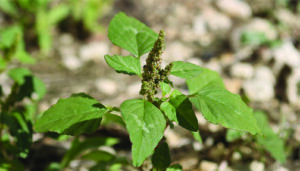
By Jeanette Castanon
When weeds begin showing resistance, it’s not a case of the herbicide changing the weed, it’s a simple “survival of the fittest” case, according to a Texas A&M AgriLife Extension Service specialist. Scott Nolte, Ph.D., AgriLife Extension weed specialist, College Station, said the common misconception is the herbicides cause changes. Instead, it’s mainly the inherited ability of a species to survive. “The problem is these resistant plants become parents because they were not killed out,” Nolte said. “It’s more of a selection, because they were left.”
Target-site mutation is the most common cause of herbicide resistance, he said. This is where a change at the target site prevents the herbicide from binding or otherwise disabling the action, thus preventing herbicidal activity. “It’s like a lock and key and someone changed the lock, so the key no longer works,” Nolte explained. Repeated use of herbicides with a single site of action promotes selection for resistant weeds. It kills out the susceptible biotypes and leaves only the resistant biotypes. And a single resistant weed multiplies over and over. The resistant weeds documented so far in Texas are perennial ryegrass, barnyard grass, Palmer amaranth, kochia, Johnsongrass, tall water hemp, common sunflower and mare’s tail. Nolte said weeds that are prolific seed producers develop resistance first because they have a high germination rate and reproduce quickly. Extended germination periods are also a problem. “If they are highly susceptible to an herbicide and everything around is killed, there is nothing for these surviving weeds to cross-pollinate with,” Nolte said. “So, they can only reproduce the resistant biotype.”

“If only 10,000 of those germinate and 98% are killed by the herbicide, then 200 seeds are still surviving,” Nolte said. Producers have to get into the practice of rotating modes of action in their herbicide programs, he said. “I know the weeds are still growing. And sometimes it doesn’t pencil out to keep treating,” Nolte said. “But I can’t tell you to do nothing. We have to use what we do have to slow them down.” “But if you suspect resistance, you have live plants next to dead plants. good control of most weeds, but not a few, take action,” he said. “Be aware of the weeds on the list that are resistant and start taking steps early to make sure you don’t have to spend the money later. If you suspect resistance and want a population tested, you can contact me, and I will test it.”
If resistance is confirmed, Nolte said, immediate steps to take are:
- Eliminate the resistant weed population to limit or prevent seed set and shed.
- Don’t use the same herbicides and don’t let the plants go to seed.
- Prevent movement of the resistant population to other fields by cleaning all equipment.
- Implement a weed-management strategy to prevent future occurrences of resistant weeds.



